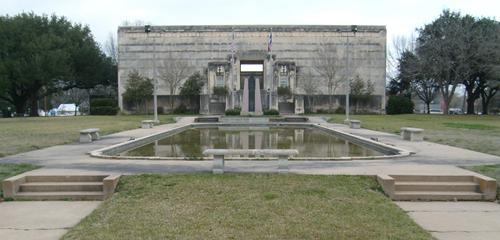|
|
I
have a little gold-framed picture on my mantle at home that is quite
dear to me.
The photograph is of Dr. Pat Wagner of Shiner
and me. In the picture, we are posing proudly with Dr. Wagner's
famed "Come and Take It" cannon. Wagner, better known to all as
"Dr. Pat," politely agreed to my request for the picture-taking
session sometime back in the late 1980s.
Texas lost another of her special sons when Dr. Pat Wagner passed
away.
Much is owed to Wagner. Those of us who love Texas
history can thank him for the little cannon that is presently
on exhibit at the Gonzales
Memorial Museum. It was his love for this area and the story
of the Battle
of Gonzales that made him relentless in his efforts to recover
the old cannon and return it to the people of Texas.
Historian and respected medical doctor; Dr. Pat was passionate about
his love for Texas. He was devoted
to his community and worked hard to preserve the history of the
surrounding area.
|
 |
|
|
Dr.
Wagner and
"Come & Take It" Cannon
Courtesy of Gonzales County Archives |
|
It
was always Texas history
that seemed to be a source of pride for Wagner. He was determined
to prove that the cannon he purchased from Robert Vance of Refugio
was truly the little gun that had started the Texas Revolution at
Gonzales on October
2, 1835.
Dr. Pat acquired the cannon in 1979 and proceeded to work towards
getting the weapon authenticated as the one involved in the important
battle
at Gonzales, which is considered to be the first shot fired
for Texas independence.
An article written by Clarita Fonville Buie appeared in the January
1981 issue of Texas Highways magazine and it describes how
Wagner proved the cannon to be the one that initiated the hostilities
between Texas and Mexico.
Buie's story tells how Dr. Pat used medical instruments to photograph
the inside of the cannon. He was looking for evidence that the gun
had been spiked as described by Noah Smithwick. It was Smithwick
who had worked on the cannon in 1835.
|
Noah Smithwick's book Evolution of a State, gave Dr.Wagner
the idea that his little artillery piece might really be the one.
Smithwick was a man who paid much attention to detail. He described
exactly how the gun looked; what kind of material it was made of,
and most importantly, how long it was and the type of work he (Smithwick)
had performed on it.
|
|
|
Wagner found
proof of Smithwick's work and later when the cannon was x-rayed,
there was little doubt that the old gun was the "Come
and Take It" cannon.
Dr. Pat wasn't alone in his quest to find out the truth about the
cannon. He received help from Allen Ondrusek and Douglas Kubicek
of Lavaca County.
They helped greatly in the research.
Also, according to the Texas Highways' article, Eugene Key
of Dewville
and Lowell R. Cooper of Nixon
provided beneficial information.
The efforts of Dr. Pat and his colleagues paid off. A report from
the Smithsonian Institution ruled out the possibility of a fraud
or hoax. The little cannon was authenticated.
In later years, there were those who questioned if Wagner’s cannon
was indeed the weapon used by Texans to start a revolution with
Mexico in 1835. However, until they prove beyond a shadow of a doubt
that it isn’t authentic, I imagine most folks in these parts will
continue to believe Dr. Pat’s little artillery piece is the real
deal.
It
should also be noted that the old cannon wasn’t Wagner’s only project.
An article by Henry Wolff, Jr. in the Victoria Advocate tells
of Dr. Pat's involvement with another historical project located
in Lavaca County.
According to Wolff, Dr. Pat worked to purchase and preserve the
old George West home at Sweet
Home. Henry Wolff wrote that this was, "... the first home of
the legendary South Texas cattlemen which West built for his bride,
Kittie Searcy." Wolff noted that Wagner was involved in the placing
of a historical marker at the site several years ago.
The Come and Take It cannon and the George West home are two of
Dr. Pat Wagner's projects. I wouldn't be a bit surprised of there
were many more.
I don't pretend to know how Dr. Pat would have wanted to be remembered.
Unfortunately, I can't even say that we were close friends. But
I do recollect from the few times that we were together; there was
no doubt that he took phenomenal pride in the history
of the Lone Star State.
© Murray
Montgomery
October 16, 2012 column
More Lone
Star Diary
|
|
|
